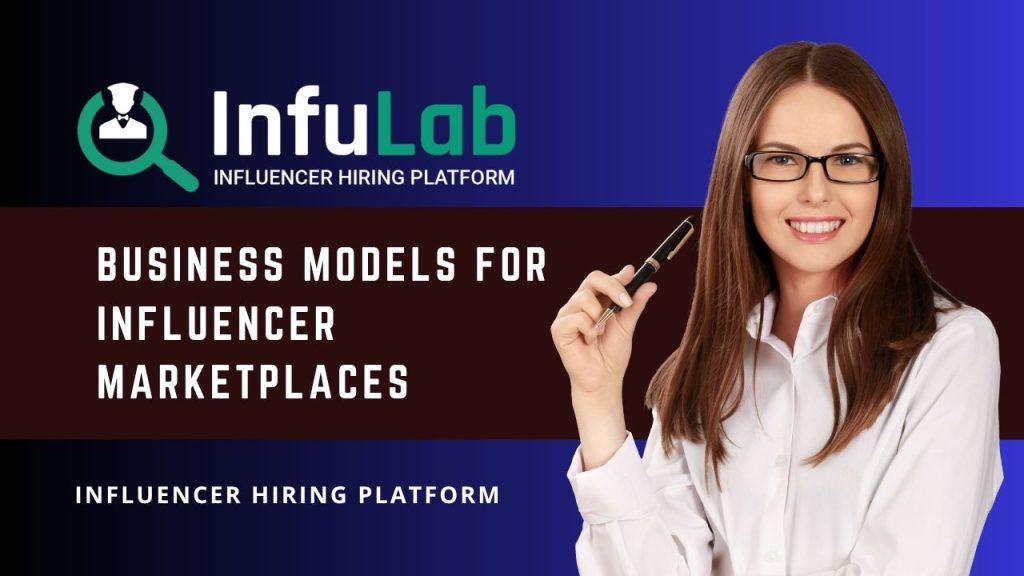What Is an Influencer Marketplace?

An influencer marketplace is an online platform that connects brands and creators. It enables discovery, negotiation, campaign management, and payments in one place. Brands use them to find influencers. Creators use them to get paid for content work. Influencer marketing marketplaces simplify those connections and tasks.
These platforms save sourcing time, let brands scale influencer programs, and measure return on investment (ROI) more cleanly. You can avoid manually hunting for creators, drafting contracts, and tracking payments across systems when a marketplace gives you access to a vast number of valid influencers relevant to your niche, budget, and strategy.
In this article, I will cover who uses influencer marketplaces, how they work, what core features matter, business models, use cases, etc.
Read till the end, and we will tell you how you can also become an owner of a successful influencer hiring platform by purchasing InfuLab.
Who Uses Influencer Marketplaces & Why They Matter
Many different parties use influencer marketplaces. Brands, agencies, micro-brands, and startups use them to reach audiences without managing dozens of creator relationships by hand. Creators of all sizes, like nano-influencers, micro-influencers, and niche creators, use them to monetize content.
These platforms deliver business outcomes. Someone in a brand can discover influencers faster by registering in an influencer marketplace. Transparent pricing helps control cost. Campaigns scale more easily. Reporting tools let firms measure influencer marketing outcomes like engagement, conversion, and ROI.
Recent data shows that influencer marketing is growing fast. Around 86% of marketers planned to use influencer marketing in 2025. Instagram still ranks among the best influencer platforms, while TikTok has grown rapidly in recent times.
Now the question is, when should you use a marketplace versus hiring influencers directly? You’ve to use a marketplace when you need many creators in a short period, lack internal talent sourcing, and want built-in verification or payment tools. Hire directly only when you have long-term relationships, specific creative control, or very bespoke content needs.
How an Influencer Marketplace Works: Step-by-Step

First, a brand or client uses these filters: target audience, content type, platforms (Instagram, TikTok, etc.), and budget. Then the marketplace lets them search for creators using filters (niche, followers, engagement, region).
Second, the brand picks up the most suitable candidates from the search results. The client can even customize the filter bar and make a list by picking names from several searches. The band then sends briefs: what content, timeline, and deliverables. Creators respond, negotiate terms (pricing, rights, etc.).
Once the terms are agreed upon from the promoter’s end, the project gets started from the marketplace system. Here, payment is often managed via escrow or any other dispute system.
Things can happen even in the opposite way. Brands post jobs for influencers with all the details. Influencers registered on the system go through posts and apply to the most suitable ones. Further things are negotiated in the personal chatbox with the client.
However, the contract is made after the content goes live, and the marketplace tracks results like reach, engagement, and conversions. Clients can see results from dashboards that deliver metrics (although this feature is available in the most advanced web apps). Disputes or revisions may happen. The creator is paid once the terms are met.
Behind the scenes, the platform handles verification (ensures audiences are real), content approval flows, dispute resolution, and payment security. These ensure trust for both brand and creator.
Core Features Every Modern Influencer Marketplace Needs
Whether you want to buy an influencer marketplace script to launch your website or find the best platform to promote your brand, go through this list of features to ease your search.
Verified Influencer Profiles
If you’ve used Facebook, X, or Instagram, you’ve seen some profiles have a tick mark beside the name. This badge states that the profile is authentic and verified by the system. A good influencer marketplace should offer verification badges, media kits, portfolio sections, audience demographics, and authenticity scores in the influencer profile page.
The same thing should happen for the client profile as well. Influencers should see how much the brand has spent on this platform, how many promoters they recruited, etc.
Robust Discovery & Matching
A marketplace should have filters for niche, social platform, audience location, and engagement rate. AI suggestions help match brands & influencers. This feature reduces discovery time. Brands can match faster. Creators get relevant briefs.
Campaign Builder & Brief Templates
Templates for creative briefs, deliverables, and schedules. Checklist for content types. Helps both sides clarify expectations. KPIs: brief completion time, revisions. UX: guided forms.
Messaging & Collaboration Workspace
Internal chat, asset upload, draft review, and feedback tools. Brands and creators collaborate in one place. Avoid third-party messengers. Helps reduce miscommunication. KPIs: revision count, time to content approval.
Payments & Escrow
A website that supports multiple payment gateways, multi-currency if needed, is more accessible to global clients. Escrow holds funds until the content is approved. Including invoices and tax documents is important for brands and creators. UX: visible payment status.
Tracking & Attribution
Use UTM or affiliate links, coupon codes, and pixel tracking. Report return on ad spend (ROAS), conversion metrics. Brands want to see the outcome, not just reach. KPIs: conversions per campaign, cost per acquisition.
Analytics & Reporting
Dashboards showing campaign performance, audience insights, and creator ROI. Provide cohort analyses over time. Helps plan future campaigns. UX: exportable reports, visual charts.
Fraud Detection & Safety
Methods to detect fake followers or bots. Engagement audits. Bot-free audience checks. Flag suspicious behavior. Brands need safety. Creators need to trust the platform.
Reputation & Reviews
Ratings from past brand-creator engagements. Reviews of content quality, timeliness. Repeat-hire indicators. Brands can pick creators with a proven track record.
Admin / Monetization Tools
Admin needs commission settings, subscription tiers, featured listings, and category management. Platform owners need ways to generate revenue and manage operations.
Business Models for Influencer Marketplaces

There are several ways to offer influencer marketplace services to both brands and influencers. Like Saas, commission-based, freemium, etc.
Among them, the most suitable option to run a marketplace business in the 21st century is commission-based earnings. You earn a fixed percentage of commission from each successful deal closed between two parties.
Another way to earn money from this business model is by offering exclusive subscriptions. For example, you take money from influencers to get their profile features on the homepage or search page of the clients.
You can also run ads, promotions, and custom services to the clients from the support channel to earn additional revenue.
However, each model has trade-offs. Subscription gives a stable income but may limit reach. Commission incentives align with performance but may reduce margin control. Freemium helps user growth, but monetization may lag.
Typical Use Cases & Industry Examples
Normally, ecommerce product launches benefit most from influencer marketplace platforms. Because they can scale across multiple creators. Local retail campaigns use micro influencer marketplace options to reach regionally relevant audiences. Ambassador programs use longer-term contracts.
Niche verticals like travel, gaming, and beauty often use specialized marketplaces. Platforms like Modash, Heepsy illustrate that. Brands run affiliate/commerce integrations via creators to drive sales directly.
Micro influencer marketplace models thrive because many small creators produce content with strong engagement.
However, a centralized influencer marketplace with a proper SEO strategy can be visible and reliable to people across all niches. From local nano influencers to national celebrities, you can let everyone make their profile on your marketplace.
You need to promote your platform in a way that all types of recruiters can come in search of the right face. But to make a centralized system, you must have advanced search filters. Robust user dashboard, multiple payment gateways, and a powerful admin panel that can access everything on the site.
You can find all those features in one script, InfuLab. A ready-to-deploy platform created by ViserLab that you can easily launch by just customizing it with your brand identity. All the features already exist in this script.
How Marketplaces Ensure Trust & Authenticity
Platforms perform verification steps such as identity checks (KYC), checking audience demographics via APIs, and engagement and follower audits.
They also enforce content governance: usage rights, disclosure compliance (e.g., required labels like “sponsored”), and takedown policies.
Trust matters because brands risk their reputation if creators mislead audiences or use fake methods. Creators need platform credibility so that brands want to hire through them.
Spotlight: How InfuLab Helps You Build Your Influencer Marketplace Fast
InfuLab from ViserLab is a PHP Laravel script that lets you create a marketplace for influencers quickly. It supports both brands and creators with dashboards, hiring tools, and payments.
InfuLab includes search filters, unlimited categories, KYC, many payment gateways (40+), GDPR compliance, and multi-language support. It covers discovery, profile verification, campaign management, messaging, payments, and analytics.
FAQs
What is the difference between an influencer marketplace and an influencer agency?
Influencer marketplace is a third-party that hosts both promoters and influencers on its website. Both sides can create projects for each other of their own will. Whereas an influencer agency has its own promoters whose skills it offers to clients for marketing.
Can I build my own influencer marketplace cheaply?
Of course, when you use InfuLab influencer hiring platform script, you can easily make your own platform, omitting the design and development cost.
How do marketplaces verify influencers?
They use KYC, audience demographics checks, and audits for fake followers or bot activity. Some use API or third-party data to validate engagement.
How do brands pay influencers through marketplaces
Brands deposit funds often via gateways or escrow. When deliverables meet criteria and content is approved, the marketplace releases payment to the influencer.
Conclusion & Next Steps
Influencer marketplace solutions let brands and creators connect efficiently. They speed up discovery, improve trust, and help measure results clearly. The right technology and operations matter.
If you’re ready to launch your influencer marketplace or private influencer hiring site, explore InfuLab for a fast, white-labelable solution.
Click here to know more about InfuLab.